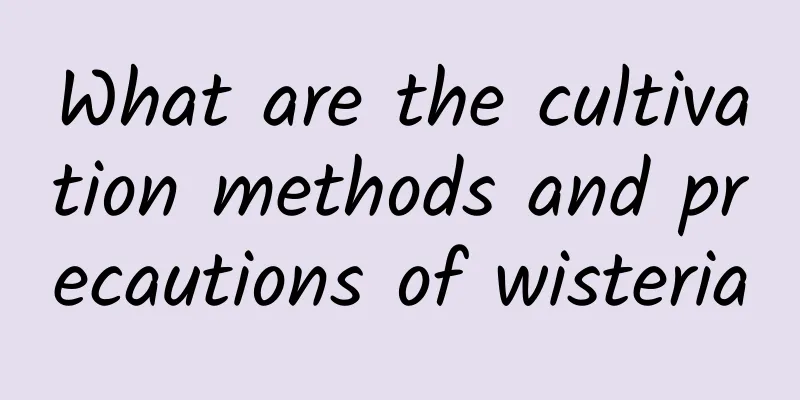What are the cultivation methods and precautions of wisteria

Wisteria growth habitsWisteria is also called wisteria, red wisteria, and yellow ring. It belongs to the leguminous family. The trunk is dark gray, with odd-pinnate compound leaves and long ovate-lanceolate leaves. Young leaves have small hairs on both sides, which become hairless when mature. Wisteria blooms in spring with a bluish-purple butterfly-shaped corolla. Wisteria is easy to propagate by sowing, cuttings, layering, division, and grafting, with sowing and cuttings being the most commonly used methods. Wisteria cultivation methodWisteria is a temperate plant with strong adaptability to the environment, is relatively cold-resistant, is not picky about soil, and can tolerate waterlogging and poor soil. However, it is best planted in loose, fertile, organic-rich soil. It likes light, is relatively shade-tolerant, and cannot tolerate direct sunlight. Watering methodWisteria has a certain degree of drought resistance, but it likes a humid environment and cannot tolerate waterlogging. The roots cannot be soaked in water for a long time, otherwise the roots will rot. Generally, it is sufficient to keep the soil slightly moist, and be careful not to allow waterlogging to occur. Fertilization methodWisteria does not have high requirements for fertilizer. 2 to 3 times of fertilization can basically meet the growth needs. Fertilizer can be compound fertilizer. Pay attention to the principle of frequent and thin application of fertilizer, and control the concentration each time you apply fertilizer. Pruning methodsWisteria should be pruned during the dormant period to ensure that the branches are evenly distributed. It has a strong branching ability, and the flower buds are born in the leaf axils. The tips of the growing branches tend to become withered and yellow, so the new branches of the year should be pruned back and cut back to half their length, and the thin and dead branches should be cut off at the base of the branches. Things to note when growing wisteriaDuring the maintenance of wisteria, the environment must be kept clean and tidy, weeds must be removed in time, yellow leaf diseased plants must be trimmed, and they must be burned in a centralized manner. Improper maintenance will lead to the appearance of snails, scale insects, and whiteflies. The main pests are scale insects, which can be killed by spraying with omethoate emulsion or marathon emulsion. Common diseases include soft rot and leaf spot, which can be prevented and controlled by spraying carbendazim and methyl thiophanate in time. |
<<: What fertilizer is good for the fortune tree?
>>: What fertilizer is good for grape vines?
Recommend
Greenhouse fungus cultivation technology and management Greenhouse fungus cultivation method and time
Auricularia auricula is also called as radish and...
In which month is mimosa planted?
Mimosa belongs to the Fabaceae family. It is a pe...
The difference between sasanqua and camellia
Different flowers Judging from the shape of the f...
Cultivation methods and precautions of dolphin flower
The flowers of the dolphin flower are beautiful, ...
How to prune Zhenlong pomelo? Pruning time and technical methods
Zhenlong pomelo pruning time Zhenlong pomelo need...
Can the fortune tree survive with only roots left? How to reroot after root rot
1. Can you survive? If only the roots of the mone...
How to grow orchids using the wet method
Orchid Planting Environment When using the wet me...
Grafting methods and time of fruit trees Technical explanation of 5 fruit tree grafting methods
For fruit trees, grafting can not only maintain t...
Cultivation methods and precautions of Buddha's hand tiger lily
1. Breeding methods 1. Temperature: It is a warm-...
Platycodon cultivation methods and precautions
How to cultivate Platycodon grandiflorum Choice o...
What to do if the leaves of the love vine become thinner
reason There are many reasons why the leaves of t...
How to propagate California poppy
How to propagate California poppy: sowing seeds S...
Why do the leaves of the thorn tree curl up?
1. Temperature problem (1) Reason: This plant lik...
The difference between grapefruit and pomelo. Are grapefruit and pomelo the same? (Difference pictures)
Are grapefruit and pomelo the same? Grapefruit an...
Common varieties of Millettia spatholobi
Millettia ternata This three-leaf chicken blood v...









